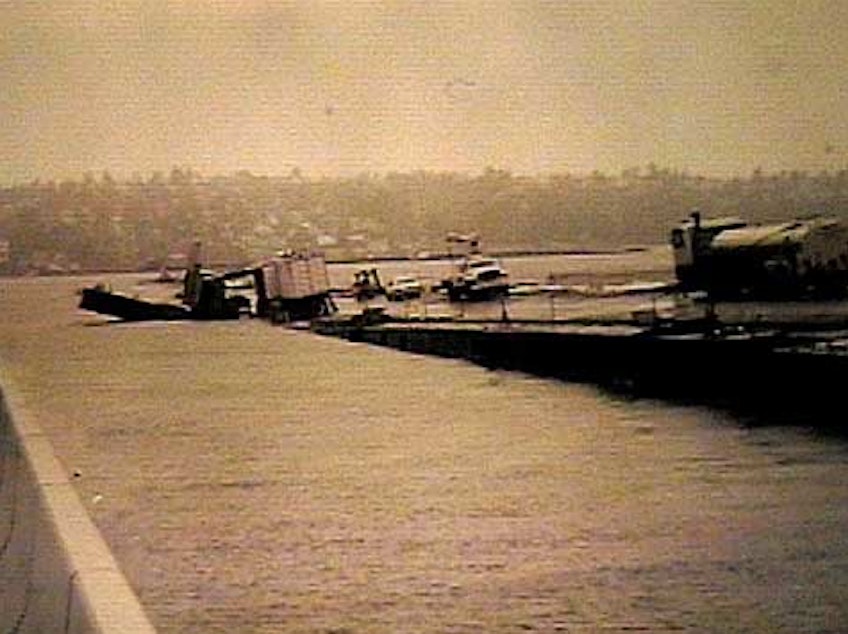Looking Back: Thanksgiving Flood Sinks Old I-90 Bridge

The Lacey V. Murrow Memorial Bridge that connected Seattle to Mercer Island sank to the bottom of Lake Washington 23 years ago this weekend.
Here in the Evergreen State, there’s something peculiar about bridges and windstorms. Take the original Tacoma Narrows Bridge back in November 1940. Bad design doomed that span from the start and earned the bridge an appropriate nickname. “Galloping Gertie” was blown down in a gale just four months after it opened.
As the narrator of a newsreel about the collapse said, “No structure of steel and concrete can stand such a strain. Steel girders buckle and giant cables snap like puny threads. There it goes!”
And then, in February 1979, there was another big blow in Washington state, along with a lot of waves. In that storm, The Hood Canal Floating Bridge broke apart and sank to the bottom.
A similar floating bridge was built across Lake Washington in 1940 to carry traffic on old US Highway 10, which later became known as Interstate 90. The bridge was named for Lacey V. Murrow, longtime director of the Washington State Highway Department. He was also brother of famed broadcaster Edward R. Murrow. The two grew up together in Skagit County.
In November 1990, the Lacey V. Murrow Bridge was 50 years old, and it was being refurbished. A new matching span had been built alongside and was already carrying cars across the lake, so the old bridge was closed to traffic for the renovation project.
Then, over Thanksgiving weekend, as often happens, a big storm blew in to Western Washington. By Sunday, the news from Lake Washington was bad. The Lacey V. Murrow Bridge was no more. Like the Hood Canal Bridge 11 years earlier, it had broken apart and sunk.
Officials and the public were stunned by the sudden loss of the old bridge. Nobody was hurt that blustery November day, but a few construction vehicles that’d been parked on the bridge for the weekend sank beneath the waves. Meanwhile, passenger cars whizzed by on the adjacent new bridge.
When they work, a floating bridge is an engineering marvel. They’re made up of narrow, barge-like, hollow concrete boxes called pontoons. The pontoons are bolted together and then tethered with heavy cables to giant concrete anchors on the lake bottom. The cables help to stabilize the bridge.
But when the old bridge sank it severed anchor cables on the new bridge. Highway officials faced a dire situation. The Murrow Bridge was on the bottom of Lake Washington. The anchor cables on the new bridge were broken, and it wasn’t safe.
Sunday night, officials decided to close the new bridge. Tens of thousands of commuters were forced to find other ways to get to work. Monday traffic was a mess.
But worst of all, the winds of November were still blowing, and the new bridge was in serious danger. Then, somebody had a brainstorm: hook up tugboats to the new bridge to keep it from blowing away. The tugboats remained on this unusual duty, holding the pontoons in place, until the anchor cables could be replaced and the new bridge made safe once again.
An investigation into the sinking found that the pontoons had been exposed to water from the renovation process and from the rain and waves of the windstorm. The hollow pontoons filled with water and sank.
Seattle radio station KIRO won the industry’s most prestigious broadcast journalism award for their coverage of the sinking of the Lacey V. Murrow Bridge.
When the plaque was presented, nobody seemed to notice that the award KIRO had won was named for Lacey’s famous brother Ed.
"Wreck of the Lacey V. Murrow" 1990 parody song by Dave Ross for KIRO Radio
This story originally aired on Nov. 26, 2012.
Video of the Sinking of the Lacey V. Murrow Memorial Bridge
